July 1 Column: Aggressive Plants

Ay yi yi! This has been a frustrating season for me because I’m really battling some aggressive plants in my flower beds. So I decided this would be the perfect topic for this week’s garden column. Here’s a link to it in today’s edition of The Spokesman-Review: Aggressive plants test patience. (or you can read my column lower in this post)
In it, I mentioned “the top five plants that are sorely trying my patience.” So here they are, along with photos, just in case you’re not familiar with some of them:
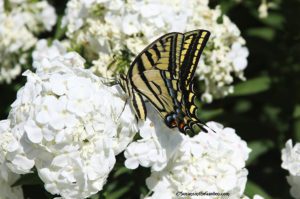
Phlox ‘David’ – Sure, it looks harmless enough with this lovely tiger swallowtail butterfly on it. But it spreads like nobody’s business!
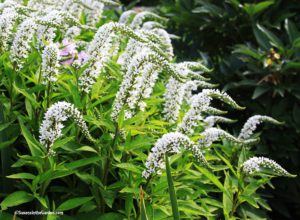
Gooseneck loosestrife (Lysimachia clethroides) – It looks so cool when it’s in bloom. But I have enough to supply all of Spokane with it!
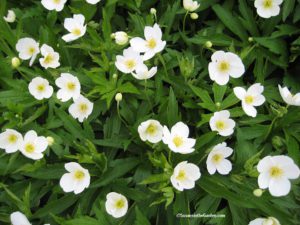
Snowdrop anemone (Anemone sylvestris) – Charming flowers, right? I wish it it would stay put. But it has spread throughout my big front perennial bed.
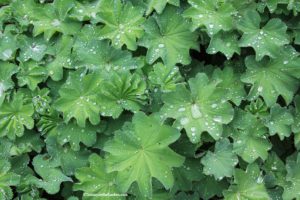
Lady’s mantle (Alchemilla mollis) – I love how this plant looks when raindrops bead up on the leaves. But I do not appreciate how easily they self-sow. I once commented something to this effect in a garden column a few years ago. Then was taken to task for it by a former Master Gardener. She said, “how could you NOT love it? I was really offended that you panned it in your column!” Sorry about that. I’ve panned it not once but twice. It still hasn’t learned how to behave itself so I’m not pulling any punches! Yes, it’s a delightful plant but you definitely need to remove the flowers before they set seed. If you don’t, you’ll have a garden full of Lady’s mantle!
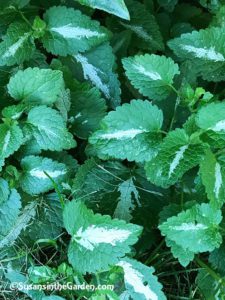
Spotted dead nettle (Lamium maculatum). This is a dandy groundcover but let me just say that it really wants to cover ground! I’d recommend either growing it in a container or keeping it in a bed edged with metal or wood. Even so, you’ll still need to keep an eye on it.
And now it’s time for this week’s “Everyone Can Grow a Garden” video. I’m trying to shoot a virtual tour of my vegetable garden once a month. That way, you can watch the transformation of it throughout the season. I shot my first one in early June, so here’s the July 1st edition:
Garden Column: Aggressive Plants
By Susan Mulvihill
It seems ironic that we gardeners are in a constant battle with plants that grow too prolifically in our gardens while babying others that apparently would rather grow anywhere else. The more I think about this, the more I wonder if it’s possible we’ve been looking at this the wrong way. Perhaps we should embrace those exuberant plants that are trying to take over our gardens.
Unfortunately, I’m having a difficult time doing that. After multiple weeding and tidying sessions in my flower beds this season, I’ve compiled a list of the top five plants that are sorely trying my patience.
The first is phlox David. With his extreme cold hardiness and white blossoms that attract butterflies and hummingbirds, how could I not love him? Well, I do love him, but only in reasonable quantities. No matter how hard I try to rein him in, David does not appear to be getting the message that I want him to stay where he was planted.
Gooseneck loosestrife (Lysimachia clethroides) is at its most endearing when blooming. Since each flower spike looks like a goose head and neck, a cluster of them gives the appearance of a gaggle of geese. Because of this, I’m frequently asked what the plants are by visitors to my garden as it’s a charming sight. The plants are only in bloom for so long, though. I’m certain it spends the rest of its days spreading its rhizomes (fleshy roots) as far as they can reach. The Missouri Botanical Garden warns gardeners that these plants “can be very aggressive in ideal growing conditions.” Wow, who knew I could dial in exactly what a plant was looking for? I should be proud of myself but when I see massive groups of them, my blood pressure rises.
While plant centers tout snowdrop anemones (A. sylvestris) for their cheerful white flowers and ease of care, these guys quickly spread through underground stems. It doesn’t matter how many I unceremoniously yank out of the ground, they always cheerfully reappear. Even when I take extra care to seek out their root systems within the soil, they are only too happy to pop back up again while seeming to say, “nice try.”
Nothing looks prettier after a rainstorm than lady’s mantle (Alchemilla mollis), when water droplets bead up on leaves that look like inside-out umbrellas. And their tiny, ethereal flowers add interest to flower beds. But if I don’t remove those blossoms before they set seed, I’ll end up with hundreds of tiny plants everywhere. Unfortunately, it took me a while to learn this trick — and then remember to do it — as I have an abundance of them in my flower beds and even in pathways.
The last plant on my hit list is spotted dead nettle (Lamium maculatum). On the positive side, it is a low-maintenance groundcover, and has colorful leaves and showy flowers. The big negative is that it’s a member of the mint family. While it looks wonderful in containers, I should have known better than to turn it loose in my garden. Try as I might to eradicate the plants, they continue to pop up in the most unlikely places. If you’re looking for plants to fill your flower beds, and don’t mind if they elbow their way into other areas, these plants are for you. But if you want low-maintenance plants that behave themselves, pass them by.
